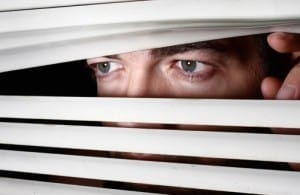Symptoms of Schizophrenia
The modern thinking on schizophrenia is that it has two types of symptoms, positive and negative. The positive symptoms, such as hallucinations and delusions, represent new ways that the sufferer has of thinking or doing things that they didn’t have when they were well. Negative symptoms, such as withdrawal, represent ways in which the sufferer has stopped doing beneficial things that they used to do before they became poorly. People can experience both positive and negative symptoms together or only one kind of symptom at a time.
The severity of symptoms can vary from day to day and even with the time of day. They also tend to reflect the season. Many people with negative symptoms say that their symptoms worsen during the autumn and improve when the good weather returns in spring. Some people with positive symptoms, on the other hand, have noticed that they are worse during hot weather and admissions to hospital with acute episodes of schizophrenia do tend to increase during the summer months.3
Rather than symptoms being present at a constant level, people with schizophrenia tend to experience periods of wellness interspersed with periods in which they can become very poorly indeed. Doctors refer to these periods of unwellness as “episodes”.
Although those people close to a person with schizophrenia may observe their behaviour as odd or disturbed, the changes in behaviour will make perfect sense to the sufferer. For instance a person with schizophrenia may be observed constantly wearing clothes of a certain colour, which may seem odd but it is quite understandable if we know that the sufferer is being told by voices that he believes come from God that good angels wear white clothes and that he must do the same.
Positive Symptoms of Schizophrenia
Positive symptoms are also sometimes called the psychotic symptoms. They are called positive because they describe features which were not present in the person before they suffered with schizophrenia and so can be considered to have been added to their mind set. Positive symptoms can broadly be broken down into delusions and hallucinations.
The person with schizophrenia will usually experience a range of positive symptoms rather than one alone. Although the different experiences can each be described separately they will usually have an overarching theme for instance the experiences may have a religious or a paranoid theme and all of the symptoms will appear to the sufferer to be taking him in one particular direction. This is one of the reasons why the sufferer finds the experiences so convincing.1 This theme may change over time, so for instance the person may go through a paranoid period followed by a religious period followed by another paranoid period. There may not be a clear distinction between each period but instead be considerable overlap between them.

Many people with schizophrenia develop the belief that their own behaviour is linked to world news items. These are called ideas of reference. (Image: RikoBest on Shutterstock)
It is vital for carers and relatives to realise that although these thoughts may seem mad to an outsider, to the person with schizophrenia they are very real indeed. John Nash is an American mathematician of some considerable repute who won the 1994 Nobel prize for economics. He also suffers with schizophrenia. When asked how he, such an intelligent, clever man, could be convinced that he was being recruited by aliens from outer space, he replied that the mad thoughts came to him in exactly the same way as his sane thoughts so why should he not believe in them?17
There is considerable evidence now to show that both hallucinations and delusions will get worse if the person with schizophrenia uses alcohol or street drugs.4
Hallucinations
Hallucinations can take four forms: visual (things that the sufferer sees), auditory (things they hear), tactile (things that they feel) and olfactory (things that they smell or taste). It is very important for carers and friends and relatives to appreciate that although they are hallucinations, it is impossible for the person with schizophrenia to distinguish them from reality. They are not imagining it or making it up: to them it is very real and often no amount of reasoning will convince the person otherwise.
It is however very important not to collude with psychotic thinking when your loved ones are having these experiences. You will do the person with schizophrenia no favours by humouring them. It is necessary to find ways of gently challenging the mad thoughts. This may appear difficult at first but it will come in time.
Visual hallucinations are when the person sees something that isn’t as it really is. In some cases they may see someone who isn’t really there but this is rare. Often they will see someone who is there distorted into someone else. For instance, a stranger may appear to be someone they know or a famous person from the TV or films. Sometimes they may see people who they know have died. This can be very confusing and distressing for them.1 They may also lose their perception of distance, thinking that things that are quite close are actually some distance away, Colours may also become extremely vivid and shapes may be distorted.
Auditory hallucinations most often take the form of hearing voices which are often, although not always, nasty to the person. Some people who do not suffer from any mental health problems hear voices and they give them no problems but most people with schizophrenia who hear voices hear nasty ones. These are what psychiatrists call persecutory voices.
These voices may also give the person instructions and put the person under great pressure to comply with them. Psychiatrists call these sorts of voices command hallucinations.
Voices can appear as one personality or there may be many. They may appear intermittently or they may be constant. They may also appear as a constant whispering or murmuring in the background. Sometimes they may converse directly with the person or on other occasions they may appear as two or more characters discussing the person in the third person e.g. “he stinks today”. This effect is thought to be more specific to schizophrenia than to other types of psychotic illness.5 Some people who hear voices will try to converse audibly with them and may even shout at them in frustration.2
Tactile hallucinations are sensations of being touched. Sometimes these will occur when there is nobody else around but sometimes they occur when the person is in a crowded place such as a bar or tube train. Often they will have a sexual dimension and the person will feel that they are being touched in intimate places of their body which can lead to conflict with the people around them.
Olfactory hallucinations are hallucinations of smell and taste and are less common in schizophrenia. The person may smell burning or sulphurous smells or smell gas and feel compelled to report it to the gas company. This can happen frequently several times a day. One young man used to smell cannabis being smoked in public places and would call the police to report it.1 These kinds of hallucinations may also involve a heightened awareness of their own or other people’s body odour.
Hallucinations of taste are also very troublesome. This often involves the person perceiving a metallic taste in their drinks or food. If the person is also suffering with paranoid delusions they can then combine both of these ideas and conclude that they are being poisoned by the person preparing their food. This may result in the patient refusing all food and becoming seriously emaciated.16
It should be noted that schizophrenia is not the only condition that causes hallucinations. Recovering alcoholics often experience visual hallucinations and extreme tiredness will very often cause auditory ones. Certain street drugs will also cause hallucinations and there are many organic conditions that can affect brain function and cause hallucinations
Delusions
Delusions are fixed and unshakeable beliefs that do not correspond to the real world. They are false ideas which are not corrected by any reasoning. Remember that delusions are very real to the person with schizophrenia: they are only mad thoughts to the outsider.
Delusions may manifest themselves in a number of ways. These are a few:
Colour symbolism

Perceiving hidden messages in the colours of cars in the street called colour symbolism is a feature unique to schizophrenia. (Image: Sunny Toys on Shutterstock)
Colour symbolism is a feature of schizophrenia that does not occur with any other mental health condition. The sufferer will perceive different colours as conveying messages to him. These messages may come from God, aliens or some other higher power. They may perceive these messages from the colours of cars that pass them in the street or colours of clothes that other people are wearing. Sufferers experiencing colour symbolism may become extremely sensitive about the colours of the clothes that they are wearing or may change the colour scheme in their room suddenly and without explanation.1
Religiosity or religious delusions
One of the features of schizophrenia that appears to crop up frequently is the development of a religious dimension to delusions and hallucinations. In fact it is thought that as many as half of all people with schizophrenia will develop a religious theme to their delusions at some point and that members of the clergy are as likely to be contacted by someone entering their first episode of schizophrenia as a doctor.6
People with schizophrenia experiencing religious delusions often develop the belief that they are special or have been chosen by God to be a saint or prophet. Sometimes they will believe that they are Jesus Christ himself. Alternatively they may start to believe that they are being punished for past sins and will start to pray and fast excessively. They may start to attend places of worship very frequently where their behaviour can sometimes be disruptive.
Of course religious observance alone does not indicate mental illness. Many people are very religious especially later in life and may attend their church, synagogue or mosque frequently.
Paranoia
This is one of the most well known features of schizophrenia. Paranoid beliefs may start off as fairly low key, for instance believing that a neighbour is playing loud music deliberately to annoy them rather than just being insensitive. This may then develop into a larger belief that their neighbour is actively spying on them and deliberately harassing them.

Developing beliefs that they are being spied on is a distressing experience for many people with schizophrenia. (Image: I Stock)
As the illness progresses these beliefs can take on more florid dimensions with the sufferer believing that secret microphones and cameras have been hidden in their home to spy on them. Neighbours, workmates or relatives and loved ones may all become the centre of these beliefs or get caught up in them. However the delusions can progress even further with the person starting to believe that the government, MI5, CIA or aliens are at the root of it.1
Quite understandably the person with schizophrenia will become extremely distressed when subjected to such a campaign by such powerful agencies and remember they have no way of knowing that it isn’t all happening for real. They may become hostile to those around them, withdraw from company and start to take seemingly bizarre precautions against the spying such as constantly varying their routes to work or searching their homes for hidden devices. It may, in extreme cases, lead to violent behaviour.
Paranoid delusions tend to reflect the society or times that the person is living in, for instance by focussing on the latest technology or celebrity personality. In developed countries some people with paranoid delusions perceive hidden messages in the content of television programmes, whereas in rural communities in developing countries they may perceive messages as coming from the spirits of the forest or ancestors.15
Ideas of reference

Many people with schizophrenia develop the belief that their own behaviour is linked to world news items. These are called ideas of reference. (Image: RikoBest on Shutterstock)
This feature causes the person with schizophrenia to believe that they are associated with things that have happened elsewhere in the world or that things that they read or see on the TV, in films or in books have special relevance to them personally. Often they will believe that stories that they read and see in the news are related to things they have done and often that they have caused the event to happen. For instance one young man read about an airliner crash in France and believed that he had caused it by not going to church the previous day. The crash had involved great loss of life and the young man became extremely distressed.2
Another form that ideas of reference can take is the belief that the person is receiving hidden messages in code from words or statements. For instance, they may receive hidden messages from car number plates. One young lady who suffered from schizophrenia became upset every time she saw the word “diesel”. Her initials were S.E.L. and she interpreted the words as “die SEL” meaning that she would shortly be killed.2
Thought disorder
This involves breaks in the train of thought or thoughts becoming confused and disordered. It is very often seen as word poverty. For instance the person will get half way through a sentence and then stop dead and not be able to find the next word that they want to say.
This experience may also lead to the person inventing new words which only they understand the meaning of,7 for example “blankettyboo” for feeling sad or “growlinger” for feeling angry.14
A common feature of thought disorder is that the patient will lose their ability for abstract thinking. For instance when faced with a common proverb such as: people in glass houses shouldn’t throw stones, they may not be able to succinctly explain its meaning.
Thought disorder will often lead to the person have difficulty with the activities of daily living such as personal hygiene or domestic chores and it may also lead to their finances getting out of control.
Sometimes thought disorder will manifest itself in the person’s sexuality. They may begin to believe that they are gay even though they have been quite happily heterosexual before. They may begin to become sexually disinhibited, making sexual advances towards members of their family or towards total strangers in the street.8,9
Thought control
Sometimes people with schizophrenia may believe that their thoughts are being broadcast to the whole world or that their thoughts are being stolen. Sometimes they may believe that thoughts have been inserted into their mind.

Negative symptoms such as apathy can often be just as disabling as the positive ones and require skilled medical attention. (Image: Alexander Raths on Shutterstock)
The person with schizophrenia may believe that things that are said to them in ordinary conversation or that they hear on the TV or radio contain hidden messages for them in code. They may act on these messages or, in conversation, may try to reply to the message also in code. They may also believe that their mind has been taken over by an external agency such as MI5 or aliens.
Grandiose delusions or grandiosity
Sometimes people with psychosis will believe that they are special or chosen. They may believe that they are a saint or a prophet sent by God or that they are Jesus Christ himself. They may sometimes believe that they are the reincarnation of some famous person from history or entertainment. They may also believe that they can control the weather, world events or other people’s thoughts. Grandiose thinking can sometimes lead to dangerous behaviour when the person starts to believe that they are invulnerable or can fly and will attempt to prove it.10
Negative Symptoms of Schizophrenia
Negative symptoms are so called because they describe the absence of beneficial behaviours that were previously present in the person’s lifestyle. Unlike the positive symptoms, which have to be described by the sufferer to the doctor, negative symptoms can mostly be observed by those living with the person.
Negative symptoms may occur at any point in the progression of the condition. For instance they may be the first sign of its onset or they may appear later on after the positive symptoms have already made an appearance.
Unfortunately negative symptoms do not respond to the antipsychotic medication in the way that positive symptoms do and so they tend to be hard to shift. A further complication is that some of the older types of antipsychotics may cause side effects that are very similar to negative symptoms such as lethargy. For this reason it is the current practice in the NHS to use the newer generation of atypical antipsychotics in preference to the older ones.11
Negative symptoms manifest themselves in a number of ways. These are a few:
Apathy
The person with schizophrenia will lose interest in the things that used to be important to them: their work, school or college studies, sporting activities or friends. This lack of motivation may lead to them under-performing in these activities or giving them up altogether.
Social Withdrawal
Often this is the first sign that anything is wrong. The sufferer may retreat to their room and only come out to eat which will usually not be at normal meal times or with their family. They will often become highly insensitive to the needs of and feelings of those close to them.
Blunted or incongruous emotional responses
On hearing important news, the sufferer may display no apparent response at all or their response may be back-to-front: apparently happy at receiving bad news and then sad when hearing good. This is called emotional incongruity by doctors. The person’s speech may lack inflection or tone and their facial expressions may not change
Changes in Body Clock
Often the person with schizophrenia will experience a complete reversal in their normal body clock. They will remain awake and active during the night and then become sleepy as the day approaches. This, associated with the insensitivity towards the needs of those they live with, can cause real conflict in the home.
Patterns in symptoms
One aspect of the development of negative symptoms which is key and very often causes delay in getting medical help, is that schizophrenia most frequently starts in late teens and early twenties (in fact about three quarters of all cases occur between the ages of 17 and 25) and consequently the negative symptoms can very often be mistaken for the normal turbulence of adolescence. Moodiness, apathy, withdrawal and preoccupation with one’s body may be the harbingers of an acute phase of schizophrenia or they may simply be part of the normal emotional rough and tumble of adolescence.
It is not uncommon in schizophrenia for a pattern to emerge over time which consists of an initial phase (called the prodromal phase) in which quite subtle changes to thinking and behaviour take place which is then followed by an acute phase in which the positive symptoms will dominate and which is usually resolved by psychiatric treatment and inpatient admission. Once the positive symptoms have been brought under control, a chronic phase in which predominantly negative symptoms take over then follows. The chronic phase may last for months or even years.13
Case Study:
David, a man in his forties, who suffered a prolonged episode of schizophrenia described his negative symptoms thus:
“ I would wake around midday and my body felt as if it was made of lead. I simply couldn’t move any part of it for two or three hours. Finally I would feel able to move but couldn’t think of how to get out of bed. I simply couldn’t work out what to do next. After a while I worked out a system for getting up e.g.
1. Throw back the bed covers.
2. Get out of bed
3. Put on slippers
4. Visit bathroom
5. Put on clothes
Each step was an effort to remember and even when I had worked that out I couldn’t wash or shave until later in the day when I was more alert.”1
Conclusion
Schizophrenia is a complex condition with a mix of symptoms which doctors have classified into positive and negative. For people living with schizophrenia both positive and negative symptoms can be very disruptive to their lives. Whilst the positive symptoms can be very frightening both to the person with schizophrenia and to people living with them, the negative symptoms can also have a profound effect on the person’s ability to cope with everyday activities. Both kinds of symptoms can be present to some extent over a prolonged period and can severely restrict the person’s ability to function normally in mainstream society.
References
1. Author’s personal experiences.
2. Conversations with schizophrenia sufferers.
3. Warner R, 2000, The Environment of Schizophrenia, Brunner Routledge, P9.
4. Fuller Torrey E, 2001, Surviving Schizophrenia, Quill, p281.
5. Reveley A, 2006, Your Guide to Schizophrenia, Hodder Arnold, p6.
6. Fuller Torrey E, 2001, Surviving Schizophrenia, Quill, p361.
7. Reveley A, 2006, Your Guide to Schizophrenia, Hodder Arnold, p8.
8. Howe G, 1997, Serious Mental Illness – A Family Affair, Sheldon Press, p22.
9. Jones S and Hayward P, 2004, Coping with Schizophrenia, One World, p25.
10. Fuller Torrey E, 2001, Surviving Schizophrenia, Quill, p58.
11. Reveley A, 2006, Your Guide to Schizophrenia, Hodder Arnold, P73.
12. Jones S and Hayward P, 2004, Coping with Schizophrenia, One World, p26.
13. Burton N, 2012, Living with Schizophrenia, Acheron Press, p28.
14. Lintner B, 1996, Living with Schizophrenia, Random House, p14.
15. Lintner B, 1996, Living with Schizophrenia, Random House, p15.
16. Lintner B, 1996, Living with Schizophrenia, Random House, p19.
17. Fuller Torrey E, 2001, Surviving Schizophrenia, Quill, p54







